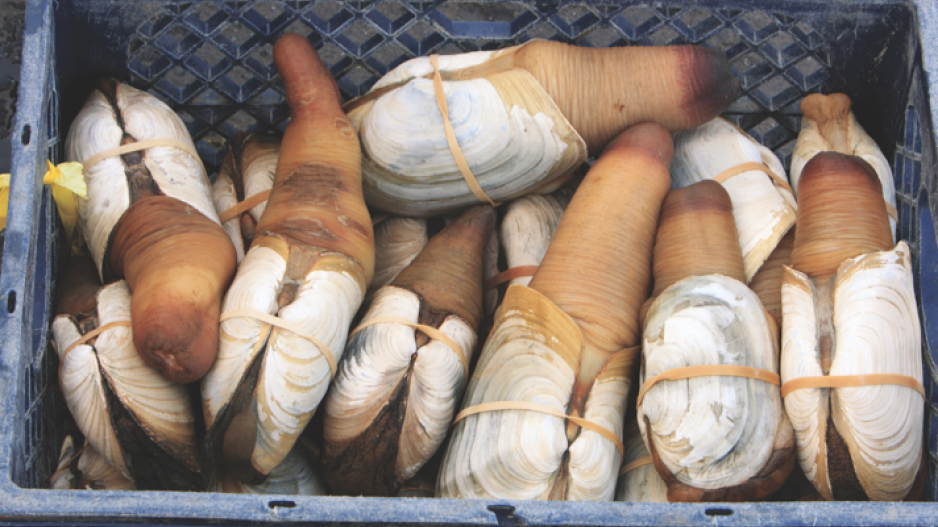In terms of export sales, salmon farming dominates the B.C. aquaculture industry, constituting 89% of total aquaculture sales, according to the BC Salmon Farmers Association.
But B.C. shellfish growers say another aquaculture business, geoduck farming, could rival salmon farming in terms of value – and that B.C. is missing the boat.
In recent years, the demand for the giant clam – especially in China – has sent prices soaring. Geoduck (pronounced gooeyduck) has a landed value of about $10 to $11 per pound in North America and can sell for $30 per pound in China.
Geoduck has become so valuable, in fact, that illegal poaching is now raising concerns about the geoduck population in Washington state.
B.C. has a wild geoduck industry that is already worth about $47 million a year in sales – more valuable than oyster and clam farming ($33 million).
But it is exclusive to divers who hold licences for harvesting the giant clam in the wild.
Alaskan and Washington geoduck growers are cashing in on the growing demand, said Roberta Stevenson, executive director for the BC Shellfish Growers Association (BCSGA).
“But here in British Columbia, the Department of Fisheries and Oceans [DFO] will not allow us to farm geoducks,” she said.
Two First Nations in B.C. – the Haida and the K’ómoks First Nation – have been pushing government to allow them to develop geoduck farms.
But according to Stevenson, DFO has been dragging its feet on issuing licences to shellfish growers.
“Basically it’s protectionism of a wild fishery,” Stevenson said. “They see it as competing, but we see the market as being insatiable. The two would not compete. It’s like wild salmon doesn’t compete with aquaculture salmon. They complement each other because the market is insatiable. We could show $10 million worth of product being grown just in Comox Valley region. The K’ómoks First Nation has huge plans to get engaged in that but the Department of Fisheries and Oceans won’t hear anything of it.”
But it’s not competition that wild harvesters are worried about, said James Austin, president of the Underwater Harvesters Association (UHA). The concern is that geoduck farms would be developed on existing wild geoduck beds already licensed to UHA members.
“We don’t want to see what we are using for the wild stock fishery expropriated from our fishery because then it’s just a reallocation,” Austin said.
There are 130 shellfish growers that belong to the BCSGA, most of them small independent operators. The shellfish industry provides roughly 1,000 full-time jobs in rural and coastal communities and generates roughly $33 million a year in sales. It could be a lot bigger, Stevenson said.
“It’s troubling to me – Prince Edward Island grows twice as much shellfish as all of British Columbia, and look how teeny tiny it is. British Columbia’s just missing the boat on this.”
Eric Gant, president of Manatee Holdings, has been trying for decades to develop the geoduck aquaculture business in B.C. He has partnered with the Haida First Nation through a joint venture with Haida Seafood Products in an attempt to develop a hatchery and farm that would cultivate geoducks, sea cucumber and scallops.
“It has a biomass potential that would rival salmon,” Gant said. “It has an economic potential that would surpass salmon.”
As Austin points out, some licences for cultivating geoduck have been issued already, but he said new federal regulations that are needed to see geoduck farming established in B.C. have been held up for years.
Even if DFO gets around to issuing licences for geoduck hatcheries and farms, it would take several years before they start producing a product, Austin said, because an initial crop could take up to 10 years to mature.
The DFO did not respond to questions from Business in Vancouver by press time. •




